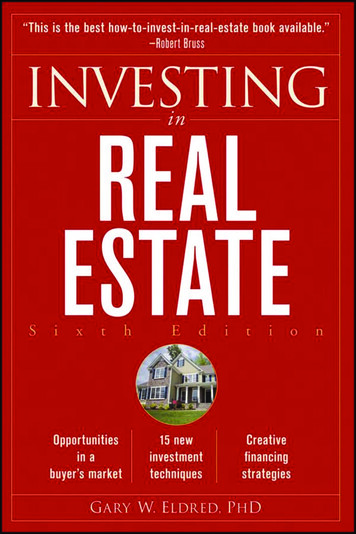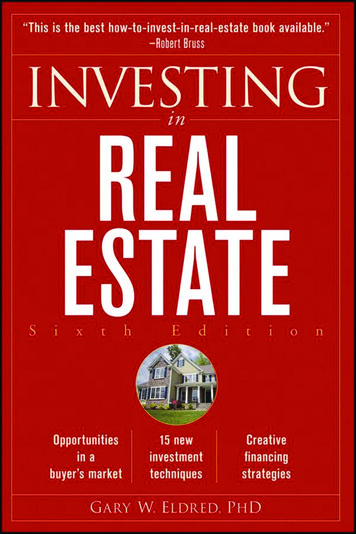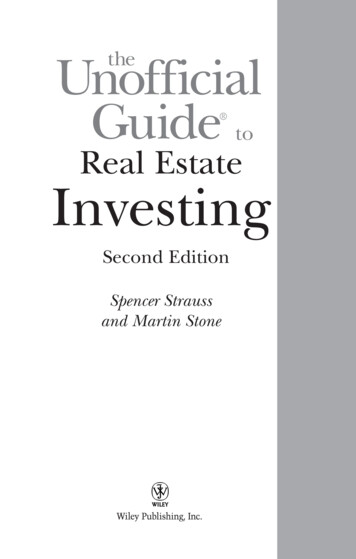
Transcription
STYLE INVESTING FOR REAL ESTATE :AN INTRODUCTIONBNP Paribas REIMApril 2019
STYLE INVESTING FOR REAL ESTATE : AN INTRODUCTIONMAURIZIO GRILLI - HEAD OF INVESTMENT MANAGEMENT ANALYSIS AND STRATEGYFOREWORDOne of the motives that led us to research the application of style (or factor)1 investingto the real estate sector descends from our desire to describe real estate investment toinvestment generalist or specialists of other asset classes. It is well known that direct realestate investments is more illiquid than other major asset classes such as bonds and equity.Moreover, real estate jargon is very technical.The combination of these dynamics has resulted in some investors believing that real estateis fundamentally different from other major asset classes. However, all asset classes canactually be explained in terms of risk and performance. This is exactly what we like about styleinvesting, as we can use it as a tool to create a link between the ‘classical’ asset managementand the real estate worlds.Style investing in the stock market has been studied since the 1970s. Nowadays, this approachhas become very popular and is increasingly gaining media exposure. Why? Because styleinvesting methodology is intuitive, albeit rigorous and data-driven, and can be applied tothe reality of day-to-day investment. In short, the beauty of this methodology is that itcreates the link between behavioural finance and quantitative analysis. Through the adoptionof style investing, investors can spell out their preferences in terms of risk and reward whilethe manager, on the other side, can create tailor-made solutions that cater to their preciseneeds. In short, style investing brings a quantitative discipline element to the choices activemanagers make.While most of the research on the subject has been performed for the stock market, stylesseem to be relevant for other asset classes such as bond, currencies and commodities. As aresult, there is no real reason why we should not be able to apply the methodology to realestate investment. The features of the stock and the private real estate market are not easilycomparable but the principles that regulate performance and risk are nonetheless universal.Specifically, the challenge is to adapt these principles to the specificities of real estate.Real estate portfolio allocation theory has not significantly evolved over the last two decades.Optimisation-based allocation models have shown limits, partly as a result of data availabilityand quality issues. Even nowadays, although a lot of data is now available, these methodologiesare still opaque in nature and ineffective to some extent.Style investing is a powerful tool for successfully advising investors. Our ultimate aim is toprovide our investors with cutting-edge, tailor-made investment strategies at a reasonablecost.In this primer report, we provide an overview of style investing as a framework that incorporatesfactor-exposure decision-making into the construction process of a real estate portfolio. Thefollowing paper will look into the practical implications of this methodology.1- We will use the two terms interchangeably in this paper.2
STYLE INVESTING FOR REAL ESTATE : AN INTRODUCTIONEXECUTIVE SUMMARY At its heart, the idea behind style investingis not to impose to investors what is bestin theory but to provide them with theinformation that they need to choose whatis right for themselves. This style-basedapproach stresses the central role of theinvestor and it enables the manager tocreate ’tailor-made’ solutions that cater tothe specificities of each investor or, morebroadly, investor type The allocation process is not explained interms of markets or sectors but rather in theform of style factors, which are related tospecific performance and risk metrics. Theexecution of a strategy based on the explicituse and combination of style factors addsanother layer of robustness to investmentanalysis, by making the process of portfolioallocation more transparent, quantitativeand rigorous Our analysis has highlighted six stylefactors that are relevant for real estateinvestment. These style factors are: growth,yield, low volatility, liquidity, quality andvalue. Each of these factors is characterisedby a specific investment rationale. We havescored more than 140 European marketsectors for each of the six style factors.The variables retained can be of differenttypes, including a) real estate-based and b)other indicators related to demographics,economics and other relevant indicators Our methodology is aimed at ranking allmarkets according to each of the six factors.This ranking is then used to facilitatethe task of portfolio allocation accordingto investor preferences in terms of riskand performance. The choice of specificinvestment criteria increases the chance ofmaximising returns and mitigating risk The diversification rationale of portfoliotheory can be also applied to style investing.Rankings generated by factor analysis tendto be largely uncorrelated. As a result,different investors or investor types havea high chance to come up with differentportfolio allocations. Improved portfoliodiversification is one of the key reasons foradopting style-based strategies Style-based investing is an effective hybridbetween passive and active strategies.However, while we are quite favourableabout style investing, we should nonethelessreiterate that manager skills explain a largepart of the performance and the choice of acapable and experienced manager remainsfundamental The analysis is performed by using bothhistoric data and forecasts. Publiclyavailable and external providers’ data aresupplemented by our extensive databankand in-house proprietary forecasts. Ourforecasts provide both 5 and 10 yearsestimates for rental growth, yield shift andtotal returns for all the markets we analyse.We look at all sectors, namely offices, retail(high street, shopping centres and retailwarehouses), industrial, residential andalternative real estate3
STYLE INVESTING FOR REAL ESTATE : AN INTRODUCTIONTHE BACKGROUNDStyle investing is an analytical framework that incorporates factorexposure allocations into the process of constructing an investorportfolio. Specifically, it provides the investor with the prerogativeto select the markets that are more likely to approximate theexposures to specific objectives. The logical structure of styleinvesting is transparent, therefore the investor can control itsperformance and risk exposures.Even in a less refined fashion, examples of style investing arecountless in the stock market. For example, value investing as away to exploit attractive absolute or relative valuations has beeninvestigated in the mid-1930s. Indices designed to target specificfactors resulted in performances and risks that were differentfrom those of the market.Academic and practitioner research on style investing is extensivein the stock market. The evidence for other asset classes is not sooverwhelming but is growing and, overall, there is a consensus onthe existence of a link between performance and factor exposuresacross assets classes. Recognising factors and what drives themenables investors to transfer the emphasis of allocation decisionsfrom market to factor exposures. Moreover, this shift has animportant impact on performance. In a few instances, differentmarket allocations result in very small differences and producerelatively tight return dispersions. For example, a fund targetingthe euro zone might carry very similar results to another fundtargeting the whole of Europe. On the other hand, factor definitionscan be quite diverse and may result into relatively large returndispersions across different factors.Investment strategies can be usually defined as active and passive.Active management generally focuses on outperforming a specificmarket benchmark, while passive management wishes to simulatethe performance of a specific index. A passive strategy will try toreplicate market performance by the creation of a portfolio thatapproximates the cap-weighted allocations of the market. In thereal estate world, this is clearly difficult to replicate given thedifficulty to estimate the real size of the market. Moreover, evenassuming that a sort of market portfolio (global or European) canbe created, the size of this vehicle would be enormous2.In reality, large real estate funds try to create a proxy of the market,by assigning larger allocations to the deepest and/or most liquidcountries and sectors and allocating smaller portions, if any atall, to the thinnest and/or least liquid countries and sectors. Thisapproach aims at mitigating idiosyncratic risk but can be quitedeceptive as it tends to underestimate the dynamic features ofthe market. Moreover, the same sectors and market that areoverwhelmingly targeted by investors, are prone to overcrowdingand trade at artificially inflated prices, thereby exposing investorsto the risk of seriously damaging performance in the long term.At the other side of the available strategies range we have purealpha-seeking investing, i.e. the search of high-performance viariskier strategies and active stock-picking. Active managementof this sort is a zero-sum game, as if a manager producespositive alpha, another manager must produce negative alpha.Consistently attaining alpha over time is a daring task. However,it is worth trying. Due to the power of compounding just a 1%in return difference over a long period of time can make a hugedifference for investors. Indeed, it is no surprise that in the USactive management accounts for more than 75% of open-endedfunds3. Real estate does not make exception as a large part ofperformance is explained by stock picking.While style-based investing is to some extent a hybrid betweenpassive-type and active-type allocations, it features specificcharacteristics that define its own identity. Indeed, this strategytargets specific singularities of assets that are called style factors,which provide us with a framework to contextualise returns andrisk from an investment. How factors are constructed will beexplained in detail in the following paragraph.Exhibit 1 summarises the strategies described above and theirapplication to real estate.Exhibit 1: Strategies spectrumALLOCATIONACTIVE /PASSIVECONTROL POINTOBJECTIVEEXAMPLES – REAL ESTATEMarket-size weighting allocationPMacro (none)Reproducing a cap-weighted market Hard to implement – needs huge size and flexibility’Custom’ allocationA/PSector/MarketApproximating the market byfocusing on the deepest/most liquidsector/marketsA large number of real estate fundsStyle/factor allocationAFactorsRewarding the driving factors ofperformance and riskA fund explicitly targeting high returns and/or lowvolatilityAlpha-seeking allocationAAssetExclusively concentrating onasset-pickingOpportunistic strategies aimed at exploiting specificasset features2- MSCI has just published a paper saying that to replicate just one market’s performance, an investor would need to own 5 to 6 buildings in that market. That is because the performance of individual buildings variesso much. On this basis, it would be very difficult to create, say, a European fully-diversified portfolio, based on a country’s specific market capitalisation.3- Source: Morningstar. This statistics is about all assets and excludes money market and fund of funds.4
STYLE INVESTING FOR REAL ESTATE : AN INTRODUCTIONT H E S T Y L E F A C T O R S : M E T H O D O L O G YConservative FactorsIt is important to highlight that the same style factors that workfor the stock market might not work for real estate. In otherinstances, the same style factors will need to be redefined toreflect the specific features of real estate as an asset class.Some sort of factor-driven allocation is already implicit in somestrategies. For example, when an investor favours markets thatare expected to convey higher rental growth over the next 5 years,he is already taking a decision based on some sort of ‘growth’factor. When portfolio allocations privilege gateway cities such asLondon, Paris and Frankfurt, there is an emphasis on some sort of‘liquidity’ factor. However, the execution of a strategy based on theexplicit use and combination of style factors adds another layerof robustness to investment analysis, by making the process ofportfolio allocation more transparent, quantitative and rigorous.Investors who are familiar with the stock market can easily relateto style factors. However, our approach is partially different. Forexample, while investing in stock allows the investor to trade ona daily basis, real estate is generally held for longer periods. As aresult, some style factors such as short-term momentum are notrelevant to our purpose.Attractive FactorsAt its heart, the idea behind style investing is not to impose to four style factors in the stock market are related to the fourinvestors what is best in theory but to provide them with the cardinal virtues acknowledged by Plato in his writings5.information that they need to choose what is right for themselves.The style-based approach focuses on the fundamental role ofthe investor and it enables the manager to create ’tailor-made’ Exhibit 2: Plato’s cardinal virtues applied to investmentsolutions that cater to the individuality of an investor or investorFundamental anticipationtype. The dialogue between investors and managers thereforeJUSTICECOURAGEallows careful evaluation and choice of the combination of stylefactors that approximate the long-run targets of the former. ThePROFITABILITYmajor difference is that, within this context, the allocation processVALUEis not illustrated in terms of markets or sectors. Indeed, theseBy companies with aBy companies at atargets are usually best described by a time-varying combinationprofitable businessreasonable priceof some specific performance and risk metrics.modelThere is no conclusive list of style factors. MSCI describes factorsacross three main categories: macroeconomic, statistical, andfundamental. Arguably, the mostly largely used factors are of theLOW-VOLATILITYMOMENTUMfundamental type4.A fascinating metaphor to present style factors is to relateBy companies with aBy companies with aquantitative management to findings of behavioural financelow-risk profilepositive Alphain exploiting market imperfections, or diverging points ofview between different market participants. A visual and selfPRUDENCEMODERATIONexplanatory way to describe this link is shown in Exhibit 2 whereEmpirical evidenceAfter undertaking some in-depth analysis, we have come up witha list of what we reckon are the most important style factors inreal estate investment. These are graphically shown in Exhibit 3:Exhibit 3: Style factors for real estate4- See MSCI “Foundations of factor investing”, 2013. Macroeconomic factors include measures such as surprises in inflation, surprises in GDP, surprises in the yield curve, and other macro indicators. Statistical factor modelsidentify factors using statistical techniques such as principal components analysis, where the factors are not pre-specified in advance.5- Source: BNP Paribas Asset Management.5
STYLE INVESTING FOR REAL ESTATE : AN INTRODUCTIONEssentially, each of these style factors describes the ability to obtain some exposure to a specific combination of risk and return. Exhibit4 describes what each of the chosen style factors is about and provides a detailed explanation of the rationale behind the choice6.Exhibit 4: Selected investment n of medium-term expected total returnsMarkets featuring strong demand-supply fundamentals tend to show relatively stronger rental growthand higher yield resilience in the medium runYieldMaximisation of cash-flow levelsHigher yield markets might support performance in late-cycle marketsLow volatilityMinimisation of volatility riskRelatively stable markets have higher chances to deliver higher risk-adjusted returns, especially in lessfavourable phases of the cycle. They can also act as diversifiersQualityMaximisation of long-term, sustainable returnsSustainable, high-efficient and high-productive markets have higher chances to out-perform in the longrunLiquidityMaximisation of the ability to sell in a relatively orderly and timely fashionLarger, deeper and liquid markets make the process of disposal quicker and less costly and tend to do well inup-cyclesValueMaximisation of the chance of capturing mispricing and/or income upside Under-rented, fast-growing markets tend to do well in the short-to-medium run. These markets are particularly suitedin the short-termfor value-added strategiesThe strength of each style factor is measured for each and every market-sector we already invest or we aim to invest in Europe for atotal in excess of 140 market-sectors7. This exercise is performed by creating scores for a number of several variables and aggregatingthem to produce a unique score for each specific factor we measure. The variables adopted can be of different types. They include bothreal estate indicators and other variables related to demography, economics and other relevant factors. The analysis is performed byusing both historic data and forecasts. Publicly available and external providers’ data are supplemented by our extensive databankand in-house proprietary forecasts. Our forecasts provide both 5 and 10 years estimates for rental growth, yield shift and total returnsfor all the markets we analyse. We look at all sectors, namely offices, retail (high street, shopping centres and retail warehouses),industrial, residential and alternative real estate8.Different investment styles are expected to show diverse reactions to the exposure to each of these style factors. Exhibit 5 tries todescribe sensitivities to different style factor strategies.Exhibit 5: Factor sensitivitiesGROWTHYIELDLOW mHighMediumLowCore - For a detailed description of the methodology please contact the authors.7- Market-sectors combine the two parameters of geography and function. Examples include Berlin offices, Milan high street, Lyon logistics, etc.8- Specifically, at local level we look at: around 45 office markets, 30 high street markets, 35 logistics markets. At national level, we have 10 markets each for shopping centres, retail warehouses and residentialrespectively. Finally, we analyse a few hotel, healthcare and senior housing markets.6
STYLE INVESTING FOR REAL ESTATE : AN INTRODUCTIONAs a real estate manager aiming at creating value for our investor, we are particularly interested in understanding which market andsectors we should concentrate on, to maximise the chances of success. We have therefore developed a formal, in-house, methodologyaimed at ranking markets and facilitate the task of selecting the markets we should prioritise according to the preferred combinationof factors. The choice of relatively precise investment criteria increases the chance of maximising returns and mitigating risk.As already explained, our methodology allows us to rank each of our market-sectors for each of the six factors. The scores rangebetween 1 (least positive) to 10 (most positive). An example of the typical output for a limited number of European office markets isdisplayed in Exhibit 69.Exhibit 6: Example of market scoring – office market onlyGROWTHYIELDLOW VOLATILITYLIQUIDITYVALUEQUALITYVienna4510668La Défense362697Berlin101591010Rotterdam7910474City of London3621028These results clearly show that each market has relative points of strength and weakness. For example, Berlin scores quite well onmost indicators except yield, which is not a surprise as this market features the lowest office yields in Europe. On the other hand, theCity of London does quite well on liquidity (again, this is one of the most liquid markets in the world) and quality but not so well ongrowth and volatility. It is important to highlight that these scores are not absolute numbers but indicators of relative strength. In otherwords, the scores only display the position of a market relative to the other ones, in terms of a specific factor and at a specific point intime. Factors and scores are indeed revised every six months as relativities are expected to change.However, the speed of change in these relativities is clearly not comparable to the equivalent in the more volatile stock market. Finally,some factors relativities move quicker than others.The diversification rationale of portfolio theory can be also applied to style factors. As a result, when constructing a portfolio it provesto be useful to combine style factors that are relatively uncorrelated. Exhibit 7 shows that the ranking of the different markets for eachof these six style factors are quite different.GROWTHYIELDLOW VOLATILITYQUALITYLIQUIDITYGrowth1,0Yield0,41,0Low 0-0,2-0,40,01,0Quality0,5-0,3-0,00,30,1VALUE1,09- The reader will forgive us for not showing the entireness of the results, as this is proprietary research. Our investors, however, have a much exposure to both analysis and results.7
STYLE INVESTING FOR REAL ESTATE : AN INTRODUCTIONAs a result, different investors or investor types have a highchance to come up with different portfolio allocations. Exhibit8 shows the best market selection for two different portfoliosbased on a combination of different style factors. The onlycommon market to the two strategies is Copenhagen, whilethe others are different. Improved portfolio diversification isone of the key reasons for adopting style-driven strategies.Style-based investing is an effective hybrid between“classical” passive and active strategies. It has characteristicsthat are similar to passive strategies such as transparency.However, as active strategies, it has an active return. In thetraditional CAPM model, assets have only two main drivers:systematic risk (β) and idiosyncratic risk (α)10. Modern theoriessuch as style investing attribute part of the asset performanceto factors, i.e. the characteristics related to the asset thatexplain a large part of its performance and risk. While weare favourable about style investing, manager skills explain alarge part of the performance and the choice of a capable andexperienced manager remains fundamental.Exhibit 8: Comparison of two hypothetic portfolios targeting adifferent combination of style factors – office market only50% GROWTH / 50% LIQUIDITY50% YIELD / 50% LOW VOLATILITYCopenhagenBrusselsHelsinkiCopenhagenLa amStockholmGlasgowThe evolution of portfolio theory according to style investingis shown in Exhibit 9.While some existing strategies already offer ‘implicit’ singlestyle exposure, e.g. funds invested only in large, very liquidcountries (e.g. France and Germany), multi-style strategiescan effectively match better investor preferences and increasethe chance of outperforming the market in a sustainable form.This will be the subject of our next research paper on thismatter.Exhibit 9: Explaining portfolio performanceMarket fundamentalsand outlookManagerskillsStyleinvestingInvestor10- Systematic risk (β) arises from exposure to the market and is captured by the sensitivity of an asset’s return to the market. Since systematic risk cannot be diversified away, investors are compensated with returnsfor bearing this risk. Idiosyncratic risk (α) is used as a measure of performance, indicating when a strategy or portfolio manager has achieved to beat the market return. This may be positive or negative and is theresult of active investing. The reader will forgive us for not showing the entireness of the results, as this is proprietary research. Our investors, however, have a much exposure to both analysis and results.8
STYLE INVESTING FOR REAL ESTATE : AN INTRODUCTION 2- MSCI has just published a paper saying that to replicate just one market’s performance, an investor would need to own 5 to 6 buildings in that market. That is because the performance of individual buildings varies so much. On this basis,











